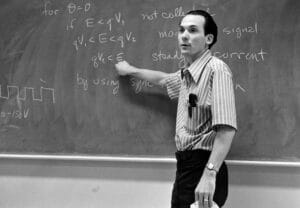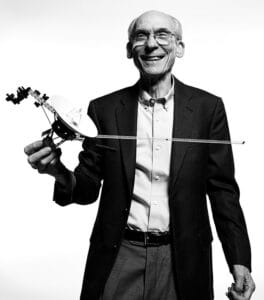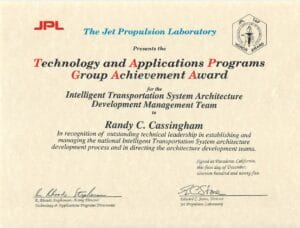Growing up in Burlington, Iowa, “Our father was a construction superintendent who enjoyed learning new things and explaining how they worked,” Stone said. His mother was a homemaker and the bookkeeper for the family business, and “Both parents had a strong work ethic. They encouraged my pursuit of scientific and technical activities such as building radios and other electronics.” He got his first formal education at Burlington Junior College (now Southeastern Community College). “My physics teacher further advanced my scientific and laboratory experience and it was due to his urging that I enrolled at the University of Chicago,” where he earned Master’s and Ph.D. degrees in physics. Just a year in at Chicago, Russia launched Sputnik 1, the first artificial satellite.
His doctoral advisor, Dr. John Simpson, was interested in cosmic rays — fragments of high-speed atoms that originate from the sun and beyond before hitting Earth. Amazingly, as a grad student Stone was able to build an instrument that rode aboard Discover 36, a classified spy satellite that took photographs of Earth. His instrument enabled him to measure the intensity of cosmic rays, and discover they were less energetic than thought. That work became the subject of his PhD thesis, and helped improve understanding of the Van Allen belts, energetic particles trapped in Earth’s magnetic field, which were discovered by the U.S.’s first artificial satellite, Explorer 1, built by NASA’s Jet Propulsion Laboratory.

In 1964, Stone was recruited to Caltech, which runs JPL for NASA, by Rochus (Robbie) Vogt, the R. Stanton Avery Distinguished Service Professor and professor of physics, emeritus, who Stone had worked with at the University of Chicago. Stone rose to assistant professor in 1967, a full professor in 1976, and the David Morrisroe Professor of Physics in 1994. Stone and Vogt “helped put Caltech on the map as a leader in the budding field of space physics,” Caltech says. “Their experiments also showed that cosmic rays are made up of atomic nuclei and not gamma rays, as had been previously theorized.” They also established the Space Radiation Lab at Caltech, which continues to play a key role in many astrophysics space missions.

Stone’s big contribution started in 1972, when he was named Project Scientist of JPL’s Voyager mission, helping to shape what the twin spacecraft would do in their “Grand Tour” of the outer solar system. “I hesitated because I was a fairly young professor at that point. I still had a lot of research I wanted to do,” he remembered later. But he accepted. Voyager 2 was launched on 20 August 1977, and visited Jupiter, Saturn, Uranus, and Neptune. It is still returning data today, making it the oldest active space probe. Voyager 1 was launched 16 days later, on 5 September 1977, and visited Jupiter, Saturn, and Neptune. Both are now in interstellar space, and both are still returning data. As of today, Voyager 1 is 15.23 billion miles from the sun, and is the farthest manmade object from Earth — its radio signals, traveling at the speed of light, take more than 22-1/2 hours to reach Earth; Voyager 2 is 12.719 billion miles from the sun. Why so different? It all comes down to the gravity boosts from slingshotting around the outer planets, which affected their speed. As of now, Voyager 1 is traveling at 38,027 mph; Voyager 2 is “only” going 34,391 mph.

Dr. Stone remained as the Voyager Project Scientist even as he accepted the spot as the Director of JPL in 1991, half-way through my own literal tenure at the lab. He also still taught at Caltech. Stone was a great manager, and made sure to recognize the contributions of many of the about 6,000 people working under him. During his 10 years as Director, Dr. Stone oversaw 21 different missions and instruments, including the Mars Pathfinder’s Soujourner Mars rover, the first wheeled vehicle to operate on another planet. Stone received numerous awards, including the National Medal of Science (1991), and the Carl Sagan Memorial Award (1999). In 2013 he appeared on The Colbert Report, where host Stephen Colbert presented him with the NASA Distinguished Public Service Medal, the agency’s highest honor for a non-government individual. Stone was also a member of the National Academy of Sciences, since 1984. Last year, the W.M. Keck Foundation awarded Caltech $4 million to endow the Edward C. Stone Professorship.

Perhaps the most memorable discovery from the Voyager mission for Stone was in 1979, when Voyager 1 encountered unusual spectral signatures and images coming from Jupiter’s moon Io. At first, nobody knew what they were looking at. Voyager engineer Linda Morabito convinced the team they were not looking at just another satellite that happened to be obscuring the view. A couple of days later, Rudolf Hanel, a co-investigator on the Voyager Infrared Experiment, realized what they were seeing was lava lakes from the first known active volcanoes on a planet outside Earth. “And that really opened our eyes that we were in for a mission that was really going to stretch us in terms of our understanding of planets, and understanding of Earth,” Stone said on the 40th anniversary of the Voyager mission. “Time after time, we just found that nature was much more inventive than our models.” Indeed, Dr. Stone was still the mission’s Project Scientist. He retired on the mission’s 50th anniversary, in 2022. Since the mission is still running, it needed a new Project Scientist. Linda Spilker was named for the role. Princeton research scientist Jamie Rankin is her deputy; Dr. Stone was her PhD advisor at Caltech. Dr. Edward Carroll Stone Jr. died June 9. He was 88, and I’ll be forever grateful to have known him.
